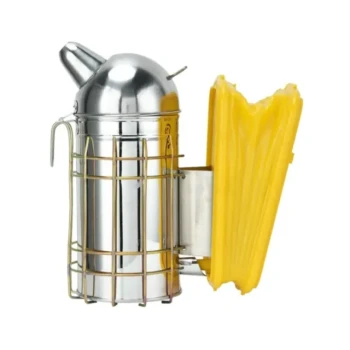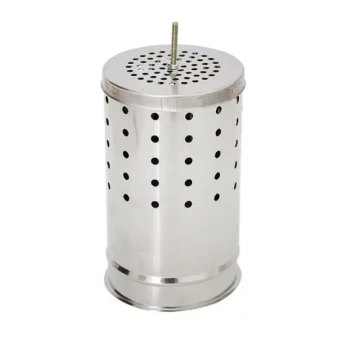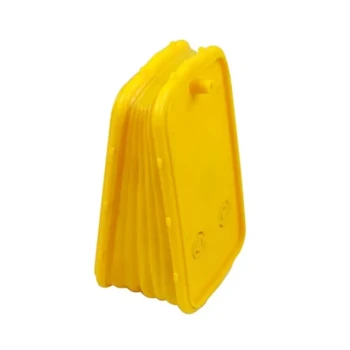The best fuels for a bee smoker are natural, untreated materials that burn slowly and produce a cool, dense smoke. Excellent choices include dry pine needles, wood shavings, untreated burlap, 100% cotton fibers, and commercial smoker pellets, as these materials effectively calm bees without introducing harmful chemicals into the hive.
The primary goal of a bee smoker is not to create a hot fire, but to generate a slow-smoldering pile of fuel that produces thick, cool smoke. The key is to choose natural, untreated materials and avoid anything synthetic or chemically treated that could harm your bees.
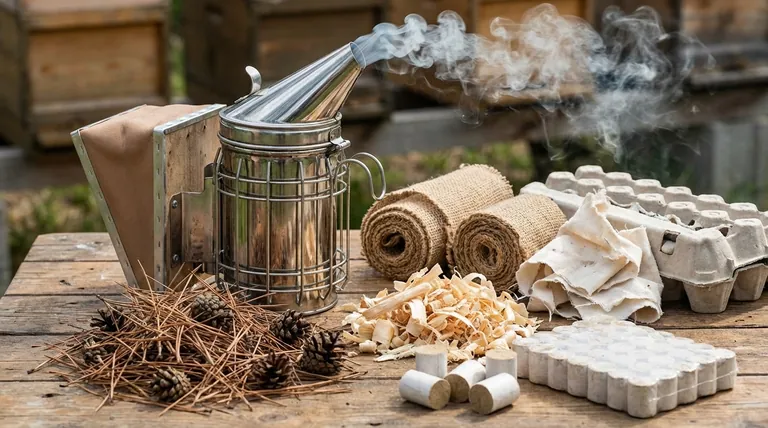
Why the Right Fuel Matters
The Purpose of Smoke
Smoke plays a crucial role in safely managing a beehive. It interrupts the bees' primary chemical communication method by masking their alarm pheromones.
When bees sense a threat, they release pheromones to alert the colony and trigger a defensive response. The smoke overwhelms these signals, keeping the colony calm and less likely to sting during an inspection.
Cool and Clean is Non-Negotiable
The type of smoke is just as important as the smoke itself. The ideal smoke is cool and white.
Hot smoke can burn the bees' delicate wings and cause them to become agitated or abscond. Smoke from treated or synthetic materials can release toxic fumes, harming or killing the bees and contaminating the honey.
Recommended Smoker Fuels: A Breakdown
Choosing a fuel often comes down to what is convenient, affordable, and readily available to you.
Natural & Foraged Fuels
These options are often free and highly effective. Ensure they are completely dry before use.
- Pine Needles/Cones: A classic choice that is widely available, lights easily, and smolders well.
- Wood Shavings or Pellets: Use untreated shavings or hardwood pellets designed for smoking food. They provide a long, consistent burn.
- Dry Grass Clippings or Hay: Easy to find, but they can burn quickly. They work best when packed down tightly.
Repurposed & Household Materials
Many common items make excellent, low-cost fuel. The critical rule is that they must be natural and untreated.
- Untreated Burlap: Strips from old burlap sacks are a beekeeper favorite. They smolder for a very long time and produce excellent smoke.
- 100% Cotton Fabric: Pieces from old denim jeans or cotton t-shirts work well. Triple-check the tag to ensure it is not a synthetic blend.
- Cardboard Egg Cartons: Untreated, paper-based egg cartons are a great option. Avoid styrofoam or plastic cartons.
Commercial Smoker Fuels
For maximum convenience and consistency, you can purchase specially designed fuels.
- Cotton-Based Pellets: These are compressed cotton fibers that are easy to light and provide a predictable, long-lasting smoke.
- Smoker "Logs": Some commercial fuels come in small logs that can be added to the smoker for a quick start or to keep the smoke going during a long inspection.
What to Avoid: Fuels That Harm Your Bees
Using the wrong fuel is one of the most common mistakes a new beekeeper can make. It can have devastating consequences for your colony.
Absolutely Never Use These
- Treated or Painted Wood: Lumber, particleboard, or painted scraps release toxic chemicals like arsenic when burned.
- Synthetic Materials: Polyester, nylon, plastics, and synthetic twine produce acrid, poisonous smoke that is lethal to bees.
- Bleached or Glossy Paper: Office paper, magazines, and junk mail often contain bleach, clays, and other chemicals that are harmful when burned.
- Green or Damp Fuel: Wet leaves, green grass, or damp wood will produce very little smoke and a lot of steam and heat, which will only anger the bees.
How to Properly Light and Use Your Smoker
The technique is just as important as the fuel itself. A properly lit smoker will smolder for hours.
Step 1: Start with a Kindling
First, you need a small, easily lit material to create embers. Crumpled newspaper (use only black-and-white print), a cardboard egg carton cup, or a commercial fire starter works well. Light it and drop it into the fire chamber of the smoker.
Step 2: Add Your Main Fuel
Gently puff the bellows to get the kindling burning well. Once you have a small flame, begin adding your primary fuel on top, such as pine needles or wood shavings.
Step 3: Pack and Smolder
Continue adding fuel and puffing the bellows until the smoker is about three-quarters full. Pack the fuel down gently with your hive tool. The goal is to choke out the open flame and create a slow, smoldering burn that produces thick, white smoke.
Making the Right Choice for Your Goal
Your choice of fuel ultimately depends on your priorities and what you have available.
- If your primary focus is cost-effectiveness: Use foraged materials like dry pine needles, pine cones, or untreated grass clippings from your property.
- If your primary focus is convenience: Purchase commercial smoker fuels like cotton pellets or logs for a consistent and easy-to-use option.
- If your primary focus is recycling: Use natural, untreated materials like burlap sacks, 100% cotton fabric scraps, or cardboard egg cartons.
By choosing a clean, natural fuel and using the proper technique, you ensure every hive inspection is calm, safe, and effective for both you and your bees.
Summary Table:
| Recommended Fuel Type | Examples | Key Benefit |
|---|---|---|
| Natural & Foraged | Dry pine needles, wood shavings, dry grass | Cost-effective, readily available |
| Repurposed Materials | Untreated burlap, 100% cotton fabric, cardboard egg cartons | Recycles common items, long smolder |
| Commercial Fuels | Cotton-based pellets, smoker logs | Maximum convenience, consistent burn |
Ensure every hive inspection is calm and productive with the right equipment from HONESTBEE.
As a trusted wholesale supplier for commercial apiaries and beekeeping equipment distributors, we provide high-quality bee smokers and reliable fuel options designed for professional use. Our products help you manage your colonies safely and efficiently.
Contact HONESTBEE today to discuss your wholesale needs and discover how our beekeeping supplies can support your operation's success.
Visual Guide
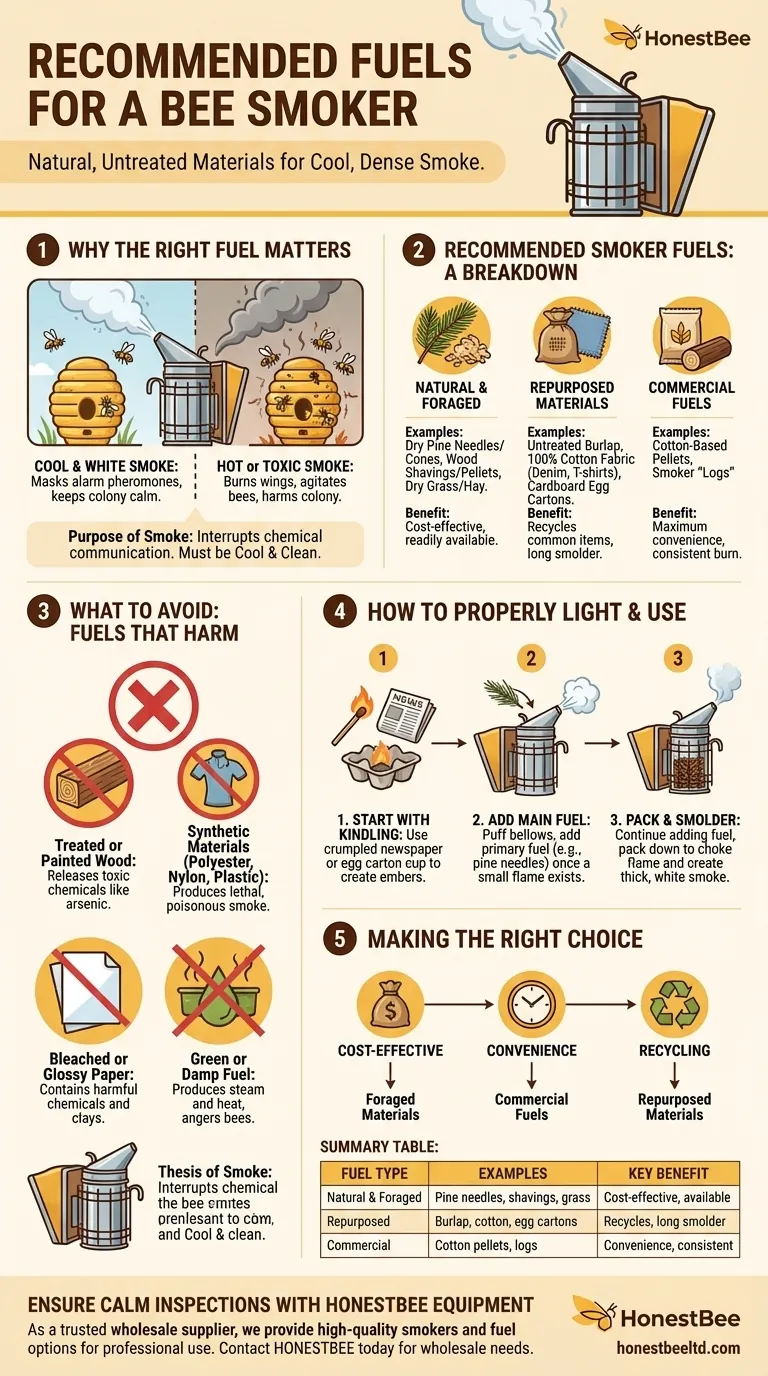
Related Products
- 54-Piece Smoker Fuel Pellets for Beekeeping Beehive Smoker Fuel
- Economy Galvanized Beekeeping Honey Bee Smoker for Wholesale
- Premium Traditional Copper Bee Smoker with Bellows
- Professional Bee Smoker with Elongated Spout and Durable Bellows for Beekeeping
- Stainless Steel Honey Bee Smoker Hive and Honeycomb Smoker for Beekeeping
People Also Ask
- What is best to burn in a bee smoker? Master the Layered Fuel Technique for Calm Hives
- What is the best material for a bee smoker? Choose the Right Fuel for a Calm Hive
- What fuels are recommended for beehive smokers? Master the Art of Calm, Controlled Inspections
- What are important considerations when choosing smoker fuel? A Guide to Safe, Effective Beekeeping
- What is the best bee hive smoker fuel? Choose Natural, Slow-Burning Fuel for Calm Bees









